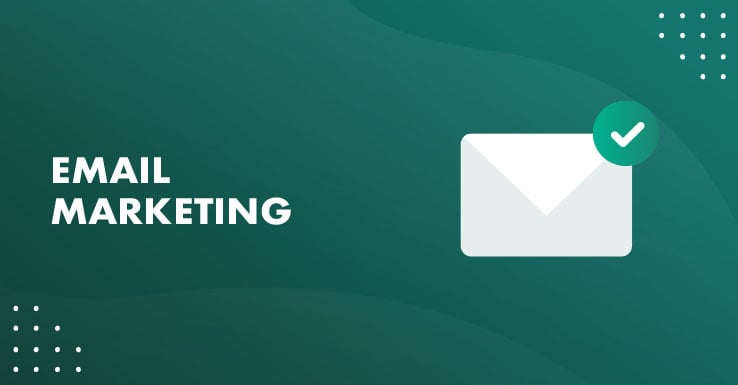In a world of crowded channels and fleeting attention, email still delivers.
And not by a little - by a lot.
Top-performing marketers treat email not just as a channel, but as an owned, high-ROI revenue driver. It’s personal, measurable, and still the most direct path to your customer’s inbox - and their wallet.
- For every $1 invested in email marketing, the return averages $36.
- Personalized campaigns can drive 6x more transactions.
- And marketers who segment their lists see 760% higher revenue.
In short? Email is your most predictable, profitable growth tool.
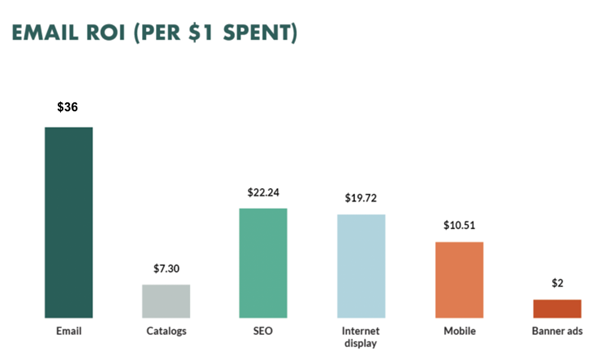
But to succeed with email marketing today, you can’t rely on spray-and-pray tactics. You need smart segmentation, relevant content, and behaviour-driven timing.
That’s why the best teams take a strategic approach - one built on data, not guesswork. To get real results from email, you need a system that scales relevance, delivers value, and meets your audience where they are.
3 Pillars of High-Impact Email Marketing Strategy
Email delivers the highest ROI of any marketing channel - but only when it’s strategic. Today’s best-performing marketers treat email not as a batch-and-blast tool, but as a finely tuned system for driving relevance, relationships, and revenue.
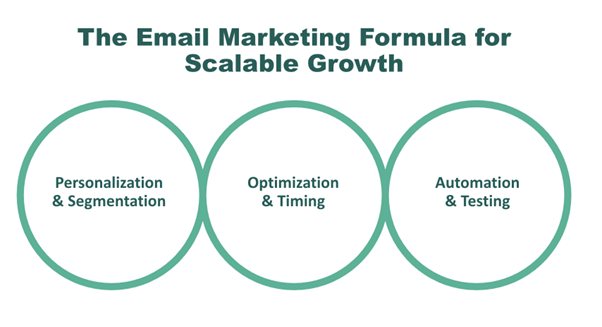
1. Know your audience, speak their language
Relevance drives results - and that starts with knowing who you're talking to. High-impact email marketers move beyond surface-level personalization and basic list segmentation. They tailor campaigns based on:
- Behaviour (pages visited, emails opened, products browsed)
- Stage in the buying journey (new lead vs. repeat customer)
- Firmographics (industry, company size, location)
The goal? Make every message feel like a 1:1 conversation - even at scale. And it works: segmented, personalized emails generate 6x more transactions than generic blasts.
SuperOffice Tip: Use dynamic fields and CRM data to segment lists, tailor messaging, and automate relevance - without the manual work.
2. Meet them where and when they’re most likely to engage
Most emails are opened on mobile - yet many are still designed for desktops.
Here’s why it matters: Mobile-optimized emails generate 4x more revenue per click than those built for desktop.
Top marketers know this - and design accordingly:
- Responsive design that looks great on every screen
- Short, punchy copy that delivers value fast
- Clear, thumb-friendly CTAs that readers can actually click on
But even the best content can fall flat if it hits the inbox at the wrong time. That’s why send-time optimization - based on time zone, engagement history, and device usage - is essential.
3. Deliver relevance at scale, and learn what works
Top performers don’t just “set and send” - they automate intelligently and iterate constantly. That means:
- Trigger-based workflows (e.g., cart abandonment, onboarding, re-engagement)
- A/B tests on subject lines, sender names, CTAs, and content
- Performance tracking by segment, time, and device
And the payoff is big: triggered emails perform 86% better than standard campaigns - and automated flows can drive 20–30% of total email revenue.
SuperOffice Tip: With CRM automation, you can trigger emails based on customer actions, funnel stage, or lifecycle timing - and scale personalization without sacrificing control.
Want to put these pillars into action faster? SuperOffice Marketing helps you automate emails, track engagement, and personalize every message at scale. Book a live demo.
Execution Playbook: 7 Email Marketing Tactics That Work
1. Personalize Your Emails (Beyond “Hi [First Name]”)
Personalization isn't about gimmicks - it’s about relevance. When your emails reflect the recipient’s preferences, behavior, or stage in the journey, they convert better. Period.
And yet: only 21% of B2B marketers use personalization.
That’s a massive competitive advantage waiting for you.
Amazon is the poster child for this. Their emails are tailored to each user’s history, behaviour, and preferences - not just their name. This personalized approach drives 35% of their total product sales.
The best part? You don’t need a huge team or tech stack to get started.
Here’s how to do it:
- Use dynamic fields like name, company, or location
- Collect useful data upfront (only what you need!)
- Segment by behaviour - not just demographics
- Use real sender names and real replies
- Include a personal signature with contact info
- Leverage AI tools to auto-generate personalized copy at scale
Pro tip: Use your CRM (like SuperOffice) to merge customer data with email automation. You’ll save time and send messages that resonate every time.
2. Segment Your Subscribers (It’s Not Optional Anymore)
If you’re still blasting the same message to your entire list, you’re leaving money on the table.
Segmentation ranks among the top priorities for B2B email marketers this year.
(See chart below for how it stacks up against other key initiatives.)
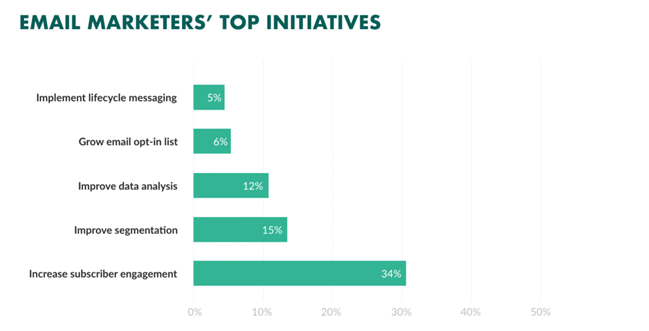
Why? Segmentation is one of the most effective ways to make your emails more relevant - and more profitable. Marketers who segment see better open rates, more leads, higher conversions - and happier customers.
Here’s why it works:
Imagine you’re hosting a local event. Which performs better?
Email A) Sending one generic invite to your full list
Email B) Sending a targeted invite only to SMBs within 20 miles
No contest. Segmentation improves precision - and performance.
Our own results? When we sent the same campaign to both a general list and an interest-based segment:
- General list: 42% open rate, 4.5% click-through
- Segmented list: 94% open rate, 38% click-through
Still, 90% of marketers don’t segment consistently. That’s your opportunity.
Start simple:
- Segment by location
- Segment by role or industry
- Segment by buying stage or behaviour
- Segment by past purchases or engagement
Need smarter segmentation? SuperOffice Marketing lets you build dynamic email lists based on location, industry, behaviour, or deal stage - all synced with your CRM. See it in action.
3. Optimize for Mobile (Because That’s Where They’re Reading)
Nearly half of all marketing emails are opened on mobile - yet many are still designed like it’s 2012. If your message doesn’t render well, load fast, and guide action on a small screen, it won’t perform. Period.
Here’s what high-impact teams do differently:
- Use responsive design that adapts to any device
- Keep copy tight and scannable - short paragraphs, bullet points, bolded value
- Design CTAs for thumbs, not clicks (big, tappable buttons > tiny links)
- Prioritize load speed - image-heavy layouts = bounces
SuperOffice Tip: Test how your emails display across popular mobile devices, then bake those mobile-friendly templates into your CRM workflows for consistency and speed.
4. Automate High-Intent Moments (Not Just Drip Campaigns)
Email automation isn’t just about saving time - it’s about striking when interest is highest. That’s why top marketers focus on trigger-based workflows tied to real behaviours - not just pre-scheduled sequences.
Examples:
- A welcome flow that activates when someone signs up
- A cart abandonment email sent 1 hour after a drop-off
- A renewal reminder sent 30 days before contract end
- A re-engagement message when someone goes cold
When your message matches the moment, performance spikes.
Trigger-based emails generate 5x higher open rates and 15x more clicks than standard newsletters.
And welcome emails - one of the most common automated triggers - can deliver up to 336% higher transaction rates and 320% more revenue per email compared to promotional sends.
Take a look at the full impact across open rates, click-throughs, and conversions:

SuperOffice Tip: Use CRM activity data (last login, last purchase, lifecycle stage) to trigger perfectly timed emails - and automate the moments that matter most.
5. Test What Matters - and Test It Often
A great email strategy is built on insight, not intuition.
A/B testing helps you learn what actually works - and what doesn’t - across subject lines, send times, CTAs, content, design, and more.
But it’s not just about small tweaks. When you test what matters most, you can unlock massive gains.
- Subject lines: Clarity vs. curiosity
- Sender name: Brand vs. individual
- CTAs: Button size, placement, or language
- Content length: Punchy vs. in-depth
- Layout: Visual vs. plain-text
Real-world example: By testing their email campaigns based on the data from A/B testing, Shop Home Med increased revenue by recipient by 306% and achieved a 24% uptick in average order value.
SuperOffice Tip: Run structured A/B tests inside your CRM and track results over time - by list, segment, or funnel stage. What works for one persona may flop for another.
6. Nail Your Subject Line (Your First Impression Counts)
You’ve got milliseconds to earn a click.
Your subject line is the gateway - and it carries more weight than most marketers realize.
Nearly half of all email opens are based on the subject line alone.
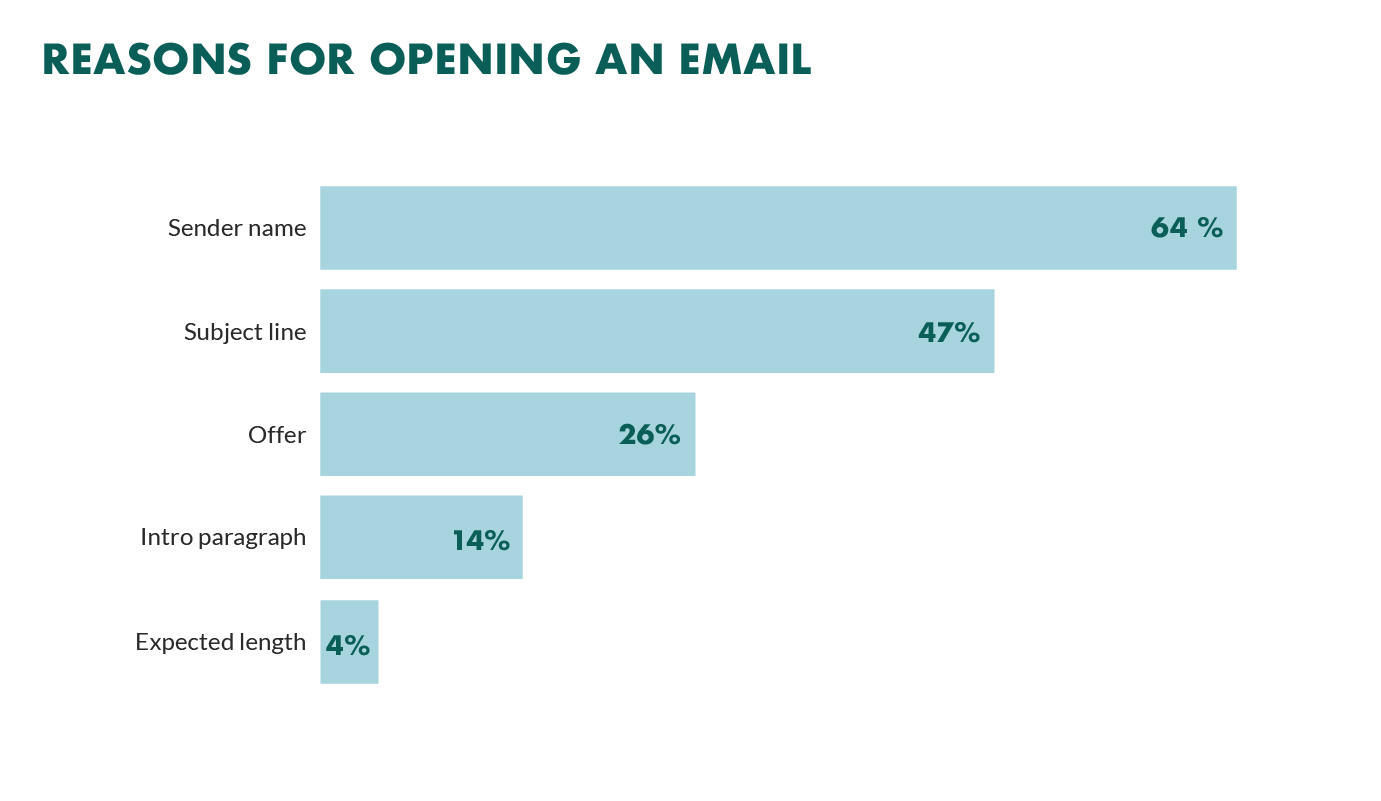
And get this:
69% of subscribers report spam just from reading the subject line.
To stand out:
- Lead with value, urgency, or curiosity - not cleverness
- Keep it under 40 characters for mobile visibility
- Use personalization (but only when it adds relevance)
- Match your subject line to what’s actually inside
Try testing formats like:
- “Quick win: [Result] in 10 minutes”
- “Still interested in [Product]?”
- “You’re missing out on [Benefit]…”
SuperOffice Tip: Use CRM insights (job role, deal stage, behaviour) to personalize subject lines beyond just {FirstName} - and increase open rates where it counts.
7. Send at the Right Time (Based on Their Behaviour, Not Your Calendar)
Timing is everything.
Even the perfect email can flop if it lands at the wrong moment.
That’s why today’s best marketers send based on audience behaviour - not just generic “best practices.” In fact, emails sent at optimized times see 33% higher transaction rates.
So when’s the best day to hit send? Turns out, there’s no huge difference between Monday, Tuesday, or Wednesday - as this data shows:
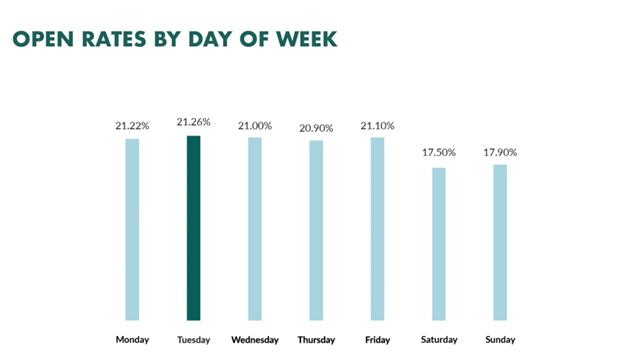
What matters more is sending when your audience is most likely to engage - and that means testing and iterating based on actual behaviour, not assumptions.
For example:
- Early AM for execs scanning over coffee
- Late evening for solopreneurs catching up
- Midweek mid-morning for B2B decision-makers
But remember: the “right time” varies by list, segment, and persona.
The only way to find it? Test.
Right message, right moment: SuperOffice analyzes past behavior and triggers personalized send times automatically, so your emails never get lost. Try it with your list.
From Campaigns to Growth Engine: Why Email Still Wins
Email isn’t just another marketing channel - it’s your most consistent, controllable, and cost-effective path to growth.
But here’s the catch: high ROI doesn’t happen by accident. It takes strategy. Smart segmentation. Clear timing. Real personalization. And systems that scale.
That’s how top marketers turn inboxes into revenue engines - and why email remains unbeatable on ROI.
- It drives 6x more transactions with personalization
- Delivers 760% more revenue when segmented
- And generates $36 for every $1 spent (on average)
With SuperOffice Marketing, you can put it all into action:
- Segment smarter with real-time customer data
- Automate follow-ups based on behaviour
- Track performance at every touchpoint
- Personalize every message - without the manual work
Your audience is still reading email - make sure every message drives results.
Ready to turn email into your top-performing channel?
With SuperOffice CRM, you can build smarter segments, trigger personalized workflows, and measure every campaign’s impact - all from one place.
Book a free demo → and see how to scale results (not just sends).
